The green color of a bird’s feathers is unusual, as it is not as prevalent as other hues. In semi-tropical and tropical regions, many brilliant green birds may be found. However, if you don’t reside in the jungle, don’t be concerned! We examine 16 distinct varieties of green birds found in North America in this article.
16 TYPES OF GREEN BIRDS
Birds with green plumage in North America are difficult to come by. Our list includes a few birds with just a tail, head, or chest with green feathers, but we also include others. They might be a lesser light shade of green than the brilliant green of tropical birds. They, on the other hand, bring beauty and ecological variety to whatever environment they live in.
1. MALLARD DUCK

Scientific name: Anas platyrhynchos
Length: 23 in
Weight: 2.4 lb
Wingspan: 35 in
If you’re thinking about green birds, the Mallard duck is probably the first to come to mind. During the breeding season, the male mallard’s head is adorned with brilliant green feathers, which results in its inclusion on this list.
Green head feathers are found on the males of various duck species, but Mallard males have the brightest. Because of its obvious plumage, a mallard drake is easily identified from October to May.
The male mallard, on the other hand, is brown, white, and gray throughout the rest of the year. Brown and gray females can be found all year.
2. GREEN JAY
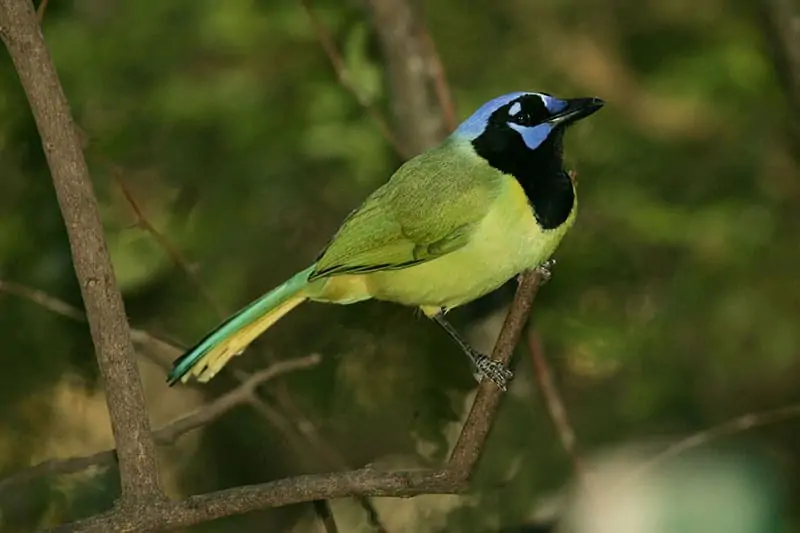
Scientific name: Cyanocorax yncas
Length: 10.5 in
Weight: 3.5 oz
Wingspan: 13.5 in
The Green jay is a brilliantly colored yellow-green bird that eats a wide variety of insects and seeds. It is found in southern Texas and the Gulf Coast of Mexico. They’re linked to the common Blue Jay and are regular visitors to bird feeders.
The Green jay’s belly is yellowish, while its back, tail, and wingtips are all brighter green. Against the rest of its green plumage, the blue and black head stands out!
3. RIVOLI’S HUMMINGBIRD

Scientific name: Eugenes fulgens
Length: 5.25 in
Weight: 0.25 oz
Wingspan: 7.5 in
Green bodies are seen in the majority of hummingbirds, but some are more brilliant. The Rivoli’s hummingbird (previously known as the Magnificent hummingbird) has dark green feathers that give off a faint metallic sheen and is one of the larger hummingbird species.
Mature males and females or juveniles are darker. A tail with dark green feathers that fade to black and white at the ends is found on both females and immature young.
They’re mostly found in Mexico, although they do go into Arizona and New Mexico on occasion. You may be able to attract them to your backyard feeders if you live near the border in the southwest.
4. GREEN PARAKEET
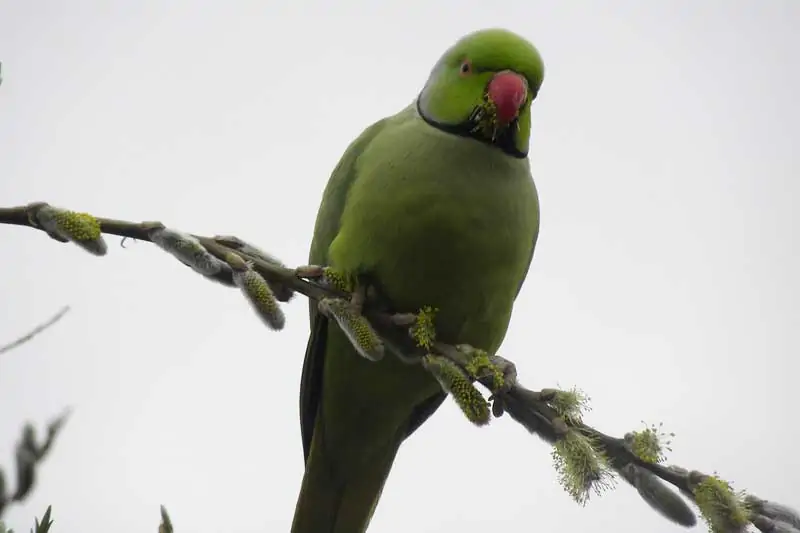
Scientific name: Psittacara holochlorus
Length: 13 in
Weight: 8 oz
Wingspan: 21 in
These parakeets are one of only a few species of fully green birds native to North and South America, having originated in Mexico. Because they’re sociable, wild populations have moved north into southern Texas and founded new colonies.
Parakeets are also a common pet variety. A self-sustaining population of these birds has formed in Florida as a result of escapes from captivity or owner abandonment. Green Parakeets live with other parrot species and forage for food after acclimatizing to subtropical and tropical climates.
5. TENNESSEE WARBLER
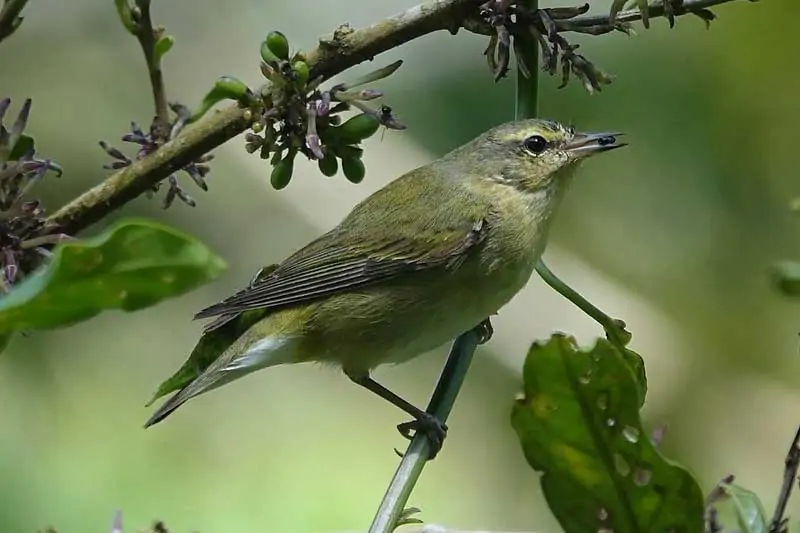
Scientific Name: Orothlypis peregrina
Length: 4.75 in
Weight: 0.35 oz
Wingspan: 7.75 in
The Tennessee Warbler is considerably more of a yellowish-green or olive color than some people would describe it. Males have a dark green back and a gray head during the breeding season. The green is more of a gradient in females, rather than being similar.
The Tennessee Warbler migrates across the United States during the winter and spends the winter in South and Central America. Throughout the spring and summer, she breeds in Canada. This warbler, on the other hand, does not raise its young in Tennessee.
6. GREEN KINGFISHER

Scientific name: Chloroceryle americana
Length: 8.75 in
Weight: 1.3 oz
Wingspan: 11 in
Streams and ponds in Mexico, southern Texas, and Arizona are home to this little kingfisher. The heads and backs of both males and femen are emerald green, with white markings on their wings and tails. The breast of male is coated in rusty orange.
Your bird feeder will not attract a Green Kingfisher. The fish and insects that this carnivorous bird eats are its favorites. The billfishers prefer to sit on top of the water before diving headfirst into the water and capturing fish. It might live its whole life near a single river system or pond, spending its whole life there.
7. VIOLET-GREEN SWALLOW
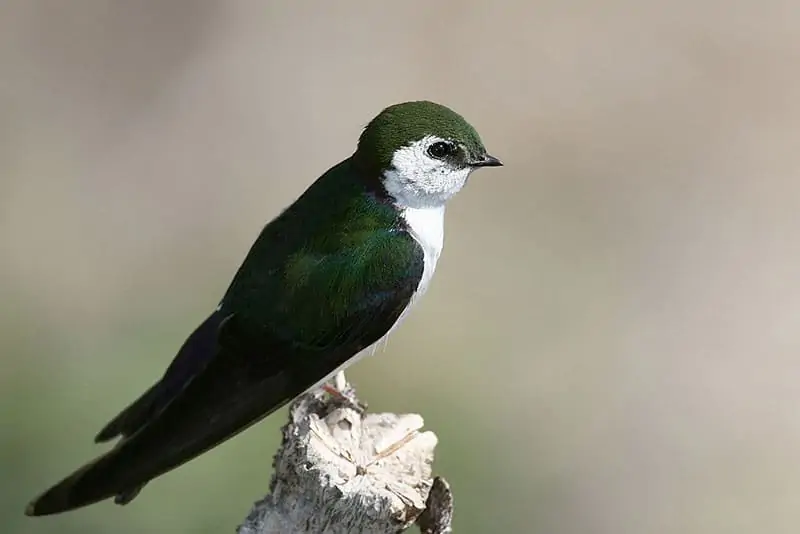
Scientific name: Tachycineta thalassina
Length: 5.25 in
Weight: 0.49 oz
Wingspan: 13.5 in
The Violet-green Swallow is a green-feathered species that lives in western North America. These feathers are somewhat iridescent, with only a greenish tint when exposed to the right light. Tree swallows, which are a much bluer color, are occasionally mistaken with them.
Winter in Mexico, and summer in the folds of cliffs, holes in trees, and birdhouses along the West Coast for the Violet-green Swallow. Insects are their main source of food, and they live in large flocks.
8. GREEN-TAILED TOWHEE

Scientific name: Pipilo chlorurus
Length: 7.25 in
Weight: 1 oz
Wingspan: 9.75 in
Green-tailed Towhees are a common species found in the remote mountain areas of the United States. Summers are spent in the mountains of Arizona, while winters are spent in Mexico and the Baja Peninsula.
They’re not the sort of green birds you’d expect, with a mostly gray body and a rusty brown head. The cords and wings of these animals, on the other hand, have a distinct olive-green hue. Greenish wings are found on both sexes. Their music has been characterized as “mewing” or “catlike.”
9. GREEN HERON

Scientific name: Butorides virescens
Length: 18 in
Weight: 7 oz
Wingspan: 26 in
This green-named bird may look nothing like its name. The majority of their feathers appear black, with the exception of their reddish-brown neck and chest. The tops of their head, wings, and back feathers are a dark forest green, which makes it easy to see where they get their name.
They prefer to nest and live in brushy areas near ponds and streams, since they are quite shy and inconspicuous. Both sexes have a similar appearance.
They may even teach their young to ‘bait’ fish by dropping little sticks into the water to attract fish up to the surface, which they both regurgitate food for.
10. CRIMSON-COLLARED GROSBEAK
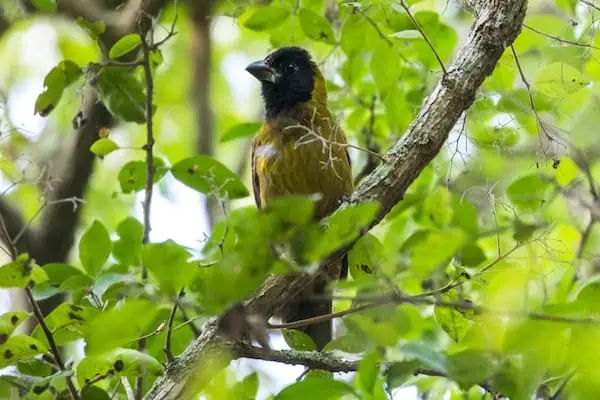
Scientific name: Rhodothraupsis celaeno
Length: 8.75 in
Weight: 1.9 oz
Wingspan: 13 in
In the United States, seeing a Crimson-collared Grosbeak is extremely unusual; they were only recently discovered in Texas. Backyard birders may see more of them in the future because of their shifting habitat patterns.
Yet, the unusual allure of these gorgeous Northern Cardinal relatives remains unchanged. The name comes from the color red and black in males, but females have a completely different appearance. The female Crimson-collared grosbeak is a murky yellow-green and olive color, save for their dark black head and neck.
11. GREEN-WINGED TEAL

Scientific name: Anas crecca
Length: 14 in
Weight: 12 oz
Wingspan: 23 in
In North America, the Green-winged Teal is one of the most well-known waterfowl species. Ponds, mudflats, and marshes across the United States, Mexico, and Canada are all home to these creatures.
Males acquire a vivid green patch on their heads throughout the breeding season, which is highlighted in black. This shows nearby females how much breeding is available.
12. PURPLE GALLINULE
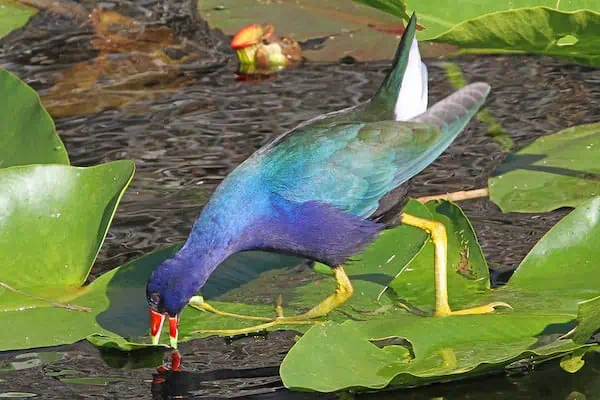
Scientific name: Porphyrio martinica
Length: 13 in
Weight: 8 oz
Wingspan: 22 in
It’s possible you’re perplexed as to how a bird with the name “purple” ended up on the list of green birds. Purple Gallinules are only half purple, thus this is the case.
The wings of an adult Purple Gallinule are a vivid green color. These gleaming green feathers blend in with the natural hues of a marshland, combining blue and purple. In addition, Purple Gallinules’ juvenile feathers gradually turn brown before turning green.
In the Southeast United States, search for these water birds. Alone along the banks of marshes and ponds, they prefer to forage. They may stand atop watery plants like lilly pads with their extra long toes.
13. GLOSSY IBIS

Scientific name: Plegadis falcinellus
Length: 23 in
Weight: 1.2 lb
Wingspan: 36 in
Since the Glossy Ibis’ neck, chest, and legs are all quite crimson on first sight, it may not seem green. The greenish-blue wings and tail of a breeding adult, on the other hand, are prominent in sunlight.
Similar green wing feathers and a near-identical call distinguish Glossy Ibises from White-faced ibises. When it comes to their habitat, the similarities stop. From Texas to Florida, then north along the Eastern seaboard to Maine, glossy ibises make their home along the Gulf Coast. Over the last century, the habitat of Glossy Ibis has expanded quickly.
14. GREEN-BREASTED MANGO
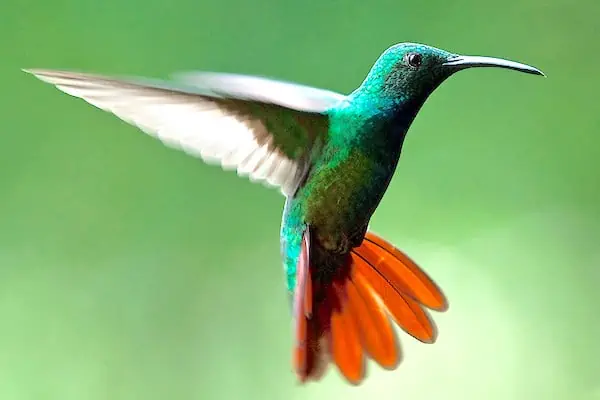
Scientific name: Anthracothorax prevostii
Length: 4.7 in
Weight: 0.2 oz
Wingspan: 6.5 in
Sightings of the Green-breasted Mango have been documented as far north as Texas, Wisconsin, and North Carolina! The hummingbird is native to Mexico and South America.
The foreskull, neck, back, and wings of both sexes are green. Males, on the other hand, stand out against females with white and black vertical stripes on their chin and belly during the breeding season. They acquire deep blue-green feathers on their chin and belly.
15. MONK PARAKEET
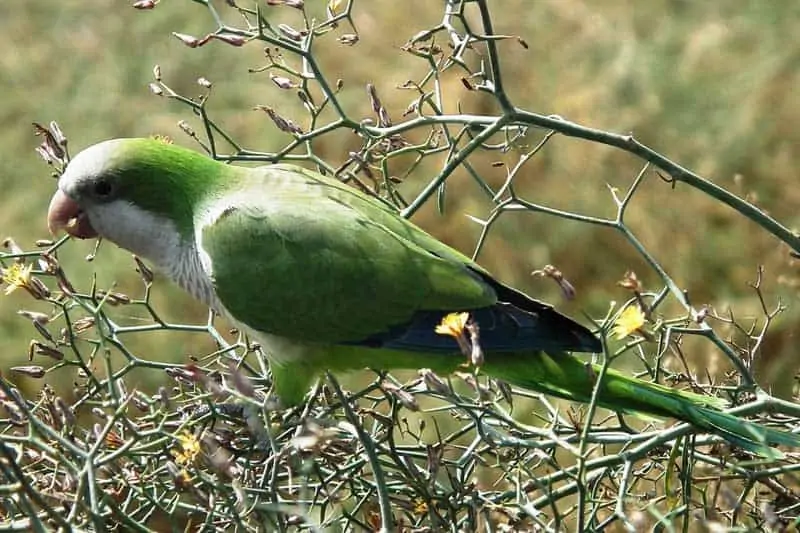
Scientific name: Myiopsitta monachus
Length: 17.7-20.9 in
Weight: 3.2-4.2 oz
The bright green plumage on the head, back, wings, and tail of both male and female Monk Parakeets is identical. Their gray face and breast, as well as their pink beak, distinguish them from other parakeets.
South America is home to Monk Parakeets. Yet, after decades of domestication, a large number of Monk Parakeets have fled the United States. In particular, in big cities, he helped establish wild populations. Several wild populations, as well as sections of Texas, Louisiana, and other places along the Gulf Coast, may be found in Southern Florida.
Nonetheless, cities like New York, Chicago, and Portland have embraced them as well because of their cold winters. In the United States, they are now the most numerous naturalized parrot species.
16. NORTHERN SHOVELER

Scientific name: Spatula clypeata
Length: 17.3-20.1 in
Weight: 14.1-28.9 oz
Wingspan: 27.2-33.1 in
Breeding adult males of this species have brilliant green heads, similar to other duck species on the list. Green wingbars are also visible when their wings are spread out, which is a rarity.
They are well recognized for their long and broad shovel-like beak, despite their emerald head and yellow eye. Their beak has lamellae (fine, comb-like ridges) on its edge that allow them to filter tiny seeds, crustaceans, and invertebrates from the water. They can be found across North America.
